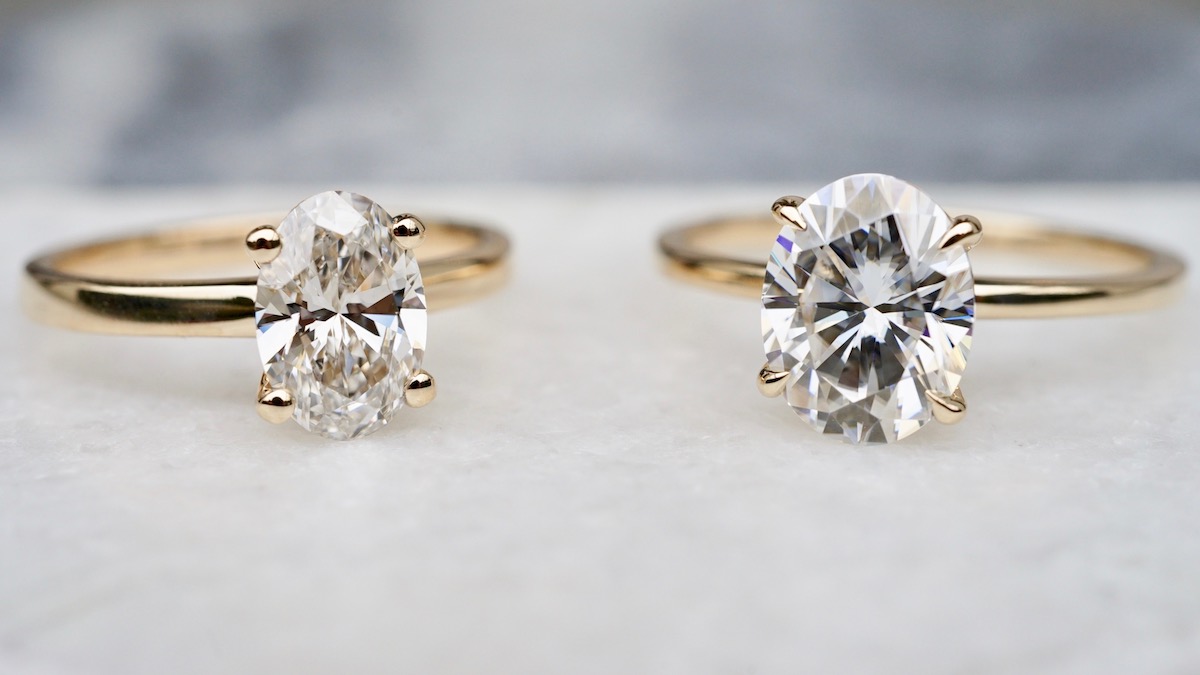Moissanite vs diamond is a debate that has intrigued jewelry enthusiasts for years. While both gems share similarities in appearance, they also have distinct characteristics that set them apart. In this article, we’ll delve into the differences and similarities between moissanite and diamond, exploring their composition, brilliance, durability, and more to help you make an informed decision when choosing the perfect gemstone for your jewelry piece.
Table of Contents
Composition and Origin
Diamond: A Natural Wonder
Diamonds are naturally occurring gemstones formed deep within the Earth’s mantle under extreme pressure and heat. Composed of carbon atoms arranged in a crystal lattice structure, diamonds are renowned for their hardness, brilliance, and rarity, making them one of the most coveted gemstones in the world.
Moissanite: A Stunning Alternative
Moissanite, on the other hand, is a lab-created gemstone discovered in 1893 by French chemist Henri Moissan. Originally found in meteorite fragments, moissanite is now synthesized in laboratories using advanced technology. Composed of silicon carbide, moissanite exhibits similar optical properties to diamond, including brilliance and fire, making it a popular alternative for those seeking a more affordable and ethical option.
Brilliance and Sparkle
Diamond: Timeless Brilliance
Diamonds are celebrated for their unmatched brilliance and sparkle, often described as “fire” and “scintillation.” Thanks to their high refractive index and superior light dispersion, diamonds reflect light in a way that creates a mesmerizing play of color and brilliance, captivating the eye and adding to their allure.
Moissanite: Dazzling Fire
While moissanite vs diamond lacks the same level of brilliance as diamonds, it possesses its own unique charm and sparkle. With a higher refractive index than diamonds, moissanite exhibits intense fire and flashes of color that can rival, and in some cases surpass, those of diamonds. This fiery brilliance is a hallmark of moissanite and adds to its appeal as a gemstone.
Durability and Hardness
Diamond: The Hardest Substance on Earth
Diamonds are renowned for their exceptional hardness, lab made diamonds, scoring a perfect 10 on the Mohs scale of mineral hardness. This hardness makes diamonds highly resistant to scratching, chipping, and other forms of damage, ensuring that they retain their beauty and value for generations to come.
Moissanite: Impressive Durability
While moissanite is not as hard as diamond, it still ranks high on the Mohs scale with a score of 9.25, making it one of the hardest known substances after diamond. This impressive durability means that moissanite vs diamond is highly resistant to scratching and abrasion, making it suitable for everyday wear in engagement rings and other jewelry pieces.
Affordability and Ethical Considerations
Diamond: A Symbol of Luxury
Diamonds have long been associated with luxury, status, and romance, commanding high prices due to their rarity and demand. However, the diamond industry has also faced criticism for issues such as unethical mining practices, labor exploitation, and environmental damage, prompting some consumers to seek alternatives like moissanite.
Moissanite: A More Affordable Option
Moissanite offers a more affordable and ethical alternative to diamonds, with prices typically significantly lower than those of diamonds of comparable size and quality. Additionally, since moissanite vs diamond is lab-created, it eliminates the ethical concerns associated with traditional diamond mining, making it a popular choice for eco-conscious consumers.
Conclusion
Moissanite vs diamond is a debate that ultimately comes down to personal preference, budget, and ethical considerations. Whether you prefer the timeless brilliance of diamonds or the dazzling fire of moissanite, both gemstones offer unique beauty and allure that can enhance any jewelry piece. Consider the factors outlined in this article when making your decision and choose the gemstone that best reflects your style, values, and preferences.

